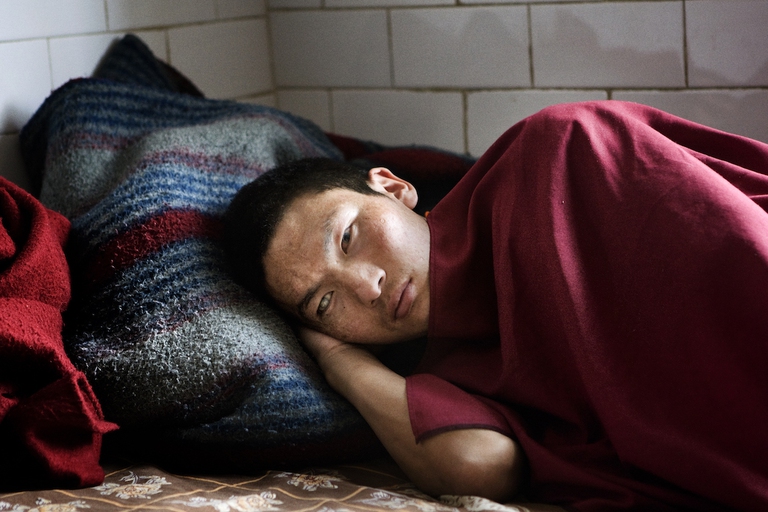
The Louise Michel is the humanitarian rescue ship saving lives in the Mediterranean. Financed by the artist Banksy, it has found a safe port in Sicily.
Out of Tibet is a lovingly compiled collection of photographs portraying members of the Tibetan diaspora around the world. It is fruit of over a decade’s work by Albertina d’Urso, an Italian photographer specialised in social and humanitarian reportages – including Welcome to Compton, snapshots of life in one of Los Angeles’s roughest neighbourhoods which won
Out of Tibet is a lovingly compiled collection of photographs portraying members of the Tibetan diaspora around the world. It is fruit of over a decade’s work by Albertina d’Urso, an Italian photographer specialised in social and humanitarian reportages – including Welcome to Compton, snapshots of life in one of Los Angeles’s roughest neighbourhoods which won her the Canon Young Photographers Award in 2007. The book and travelling exhibition Out of Tibet is a visual memory of Tibetan natives’ efforts to maintain their culture alive even outside of their homeland. It is being funded via a Kickstarter campaign that needs your support to reach the target of 15,000 euros (over $16,000).
The most famous Tibetan alive, the 14th Dalai Lama Tenzin Gyatso, was only a teenager when 40,000 Chinese troops occupied what was an independent nation in 1949. At the time, Mao Zedong was China’s new ruler and Tibet was a strategic region because of its richness in resources for mining and position on the border with India.
A government in exile, the Central Tibetan Administration (CTA), installed itself under the leadership of Tenzin Gyatso in the northern Indian city of Dharamsala in 1960. It has continued to direct a peaceful resistance in the name of Tibetan liberation ever since. This plight has received a great deal of international attention, and is at the heart of am impassioned protest movement within what is now the Tibetan Autonomous Region (TAR) under China. More than 140 people have immolated themselves since 2009 to protest what they see as the oppressive and unjust Chinese occupation.
D’Urso first visited Tibet in 2000 and grew fascinated with its people who, whilst stateless and with a government that no other country recognises, are unified by strong national symbols such as an official language and a supreme spiritual leader, the Dalai Lama. Whilst in Tibet she saw its ancient culture being repressed, but when she visited the Tibetan refugee settlement of Bylakuppe in southern India, first established in 1961, she realised that the region’s traditions, religion and culture were still alive and well in those of its people living abroad.
There are over 6 million Tibetans in the world according to CTA census data from 2010, the latest, and almost all of them live inside the TAR and neighbouring provinces. D’Urso has made it her mission to document the lives of Tibetans who have moved to India, where most of the diaspora resides, Nepal, Taiwan, the United States, Canada and Europe. What she found is that, whilst Tibetans have adapted to cultures vastly different from their own, they continue honouring their traditions and beliefs in their private lives.
It is on the shoulders of these complex circumstances that Out of Tibet stands. The book features the most touching images d’Urso has captured over the years, as well as excerpts of conversations with Tibetan refugees, an introduction by the CTA’s Prime Minister Lobsang Sangay and a forward by none other than Tenzin Gyatso himself. Supporting the book’s publication via Kickstarter simply requires pre-ordering it by the end of February. Its author hopes that one day it will be held in the hands of Tibetans who will have moved back to their homeland, as she says many hope to do, and who will look back onto their time abroad as distant, foreign memories.
Siamo anche su WhatsApp. Segui il canale ufficiale LifeGate per restare aggiornata, aggiornato sulle ultime notizie e sulle nostre attività.
![]()
Quest'opera è distribuita con Licenza Creative Commons Attribuzione - Non commerciale - Non opere derivate 4.0 Internazionale.
The Louise Michel is the humanitarian rescue ship saving lives in the Mediterranean. Financed by the artist Banksy, it has found a safe port in Sicily.
Venezuelan refugees are vulnerable to the worsening outbreak in South America: while coronavirus doesn’t discriminate, it does affect some people more than others.
In the midst of India’s coronavirus lockdown, two dozen people lost their lives in a desperate bid to return home: migrant labourers forced to leave the cities where they worked once starvation began knocking at their doors.
Behrouz Boochani returned to being a free man during the course of this interview. The Kurdish writer was imprisoned by the Australian government in Papua New Guinea for six years.
The Global Compact for Safe, Orderly and Regular Migration was signed by 164 nations in Marrakech. This is what the non-binding agreement that encourages international cooperation stipulates.
The winners of the World Press Photo 2019 tell the stories of migrants in the Americas. From the iconic image of a girl crying on the border between Mexico and the United States to the thousands of people walking from Honduras towards a better life.
The Semìno project is a journey of discovery through different countries’ food habits, offering migrants employment opportunities and allowing us to enjoy the properties of vegetables from all over the world.
Travelling across the new route used by migrants to cross the Balkans and reach Trieste in Italy, a reportage that documents the social, economic and political changes of the countries along the way.
The countries hosting the most refugees aren’t the wealthy, Western ones. An overview by NGO Action Against Hunger reminds us that refugees and internally displaced people are far from being safe.








